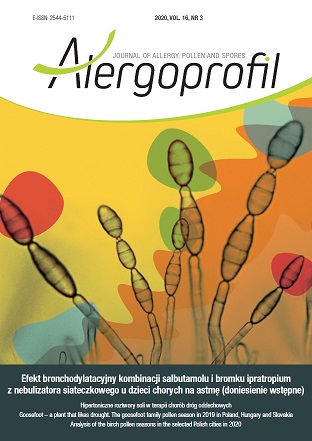Goosefoot – a plant that likes drought. The goosefoot family pollen season in 2019 in Poland, Hungary and Slovakia Artykuł oryginalny
##plugins.themes.bootstrap3.article.main##
Abstrakt
Almost all the species of the Chenopodiaceae family present in our flora flower from July–August to the autumn. Unfortunately, allergies do not take a vacation. Warm, dry July and August weather should limit pollen emissions. However, similarly to most plants in dry habitats, goosefoot are well adapted to such conditions and does not provide even a short reprieve to pollen allergic patients. However, goosefoot pollen does not have a very large allergenic significance; despite the long pollen season lasting about 3 months, pollen concentrations in the air are low and very rarely exceed the concentration of 30 grains/m3. This study compares Chenopodiaceae pollen seasons in Poland, Hungary and Slovakia in 2019. The investigations were carried out using the volumetric method (Hirst type pollen sampler). Seasonal pollen index was estimated as the sum of daily average pollen concentrations in the given season. The pollen season ranges from June to September, depending on the geographical latitude. In Hungary and Slovakia there are much longer pollen seasons than in Poland. Pollen of goosefoot family contains the panallergen profilins, which are responsible for cross-reactivity among pollen-sensitized patients. In 2019 the pollen season of goosefoot started first in Hungary, in Kaposvar on June 7th and in Slovakia, in Žilina, on June 8th; in Poland pollen season started much later, on June 14th in Szczecin and Opole. At the latest, a pollen season ended in Nitria (Slovakia) on October 16th; in Kecskemet (Hungary) on October 3rd. In Poland the season ended much earlier than in Hungary and Slovakia already on August 25th. The differences of pollen season durations are considerable, the number of days ranged from 72 to 128. The dynamics of the pollen seasons of goosefoot family show similarities within a given country and considerable differences between these countries. However, the differences of the highest airborne concentration between the countries are not considerable (25 pollen grains/m3 in Poland, 49 pollen grains/m3 in Hungary, and 30 pollen grains/m3 in Slovakia. The maximum values of seasonal pollen count in Polish cities occurred between July 26th and August 29th, in Hungarian cities between August 27th and 30th, and in Slovakian cities between August 7th and 28th. Pollen season was characterized by extremely different total annual pollen SPI, in Poland from 116 to 360; in Hungary and Slovakia within the limits 290 to 980. Droughts that occur more frequently during the summer facilitate the spread of species of the goosefoot family due to the possibility of these plants gaining new habitats.
Pobrania
##plugins.themes.bootstrap3.article.details##

Utwór dostępny jest na licencji Creative Commons Uznanie autorstwa – Użycie niekomercyjne – Bez utworów zależnych 4.0 Międzynarodowe.
Copyright: © Medical Education sp. z o.o. This is an Open Access article distributed under the terms of the Attribution-NonCommercial 4.0 International (CC BY-NC 4.0). License (https://creativecommons.org/licenses/by-nc/4.0/), allowing third parties to copy and redistribute the material in any medium or format and to remix, transform, and build upon the material, provided the original work is properly cited and states its license.
Address reprint requests to: Medical Education, Marcin Kuźma (marcin.kuzma@mededu.pl)
Bibliografia
2. Rapiejko P. Alergeny pyłku komosy. Alergoprofil. 2009; 5(1): 42-3.
3. Compes E, Hernandez E, Quirce S et al. Hypersensitivity to black locust (Robinia pseudoacacia) pollen: ”allergy mirages”. Ann Allergy Asthma Immunol. 2006; 96(4): 586-92.
4. Monoszon MCh. Opredelitel pylcy widow semojestwa marewych. Izdatielstwo Nauka, Moskwa 1973.
5. Ralska-Jasiewiczowa M, Latałowa M, Wasylikowa K et al (ed). Late Glacial and Holocene history of vegetation in Poland based on isopollen maps. Polish Academy of Sciences, Cracow 2004.
6. Huntley B, Birks HJB. An Atlas of past and present pollen maps of Europe: 0-13000 years ago. Cambridge University Press, Cambridge 1983.
7. Mandrioli P, Comtois P, Dominguez E et al. Sampling: Principles and Techniques. In: Mandrioli P, Comtois P, Levizzani V (ed). Methods in Aerobiology. Pitagora Editrice Bologna, Bologna 1998: 47-112.
8. Emberlin J, Savage M, Woodman R. Annual variations in the concentrations of Betula pollen in the London area 1961–1990. Grana 1993; 32: 359-63. https://doi.org/10.1080/00173139309428965.
9. Gehring R. The influence of the hot and dry summer 2003 on the pollen seasons in Switzerland. Aerobiologia 2006; 22: 27-34.
10. Puc M. Meteorological factors and pollen season dynamics of selected herbaceous plants in Szczecin, 2004-2008. Acta Agrobotanica. 2009; 62(2): 97-109.
11. Malkiewicz M, Chłopek K, Dąbrowska-Zapart K et al. The goosefoot in the air of selected Polish cities in 2018. Alergoprofil. 2018; 14(4): 105-10.
12. Docampo S, Recio M, Trigo M. Risk of pollen allergy in Nerja (southern Spain): a pollen calendar. Aerobiologia. 2007; 23(3): 189-99.
13. Kasprzyk I. Sezonowe zmiany koncentracji ziaren pyłku w powietrzu. In: Weryszko-Chmielewska E (ed). Aerobiologia. Wydawnictwo Akademii Rolniczej, Lublin 2007.
14. Galan C, Infante F, Ruiz de Clavijo E et al. Allergy to pollen grains from Amaranthaceae and Chenopodiaceae in Cordoba, Spain. Annual and daily variation of pollen concentration. Ann Allergy. 1989; 63(5): 435-8.
15. Gniazdowska B, Doroszewska G, Doroszewski W. [Hypersensitivity to weed pollen allergens in the region of Bygdoszcz]. Pneumonol Alergol Pol. 1993; 61(7-8): 367-72.
16. Lombardero M, Duffort O, Carreira J. Allergenic significance of chenopodpollen. In: D’Amato G, Spieksma FThM, Bonini S (ed). Allergenic pollen an pollinosis in Europe. Blackwell Scientific Publications, Oxford 1991: 128-31.
17. Rodriguez-Rajo FJ, Jato V, Aira MJ. Pollen content in the atmosphere of Lugo (NW Spain) with reference to meteorological factors (1999-2001). Aerobiologia. 2003; 19(3): 213-25.

